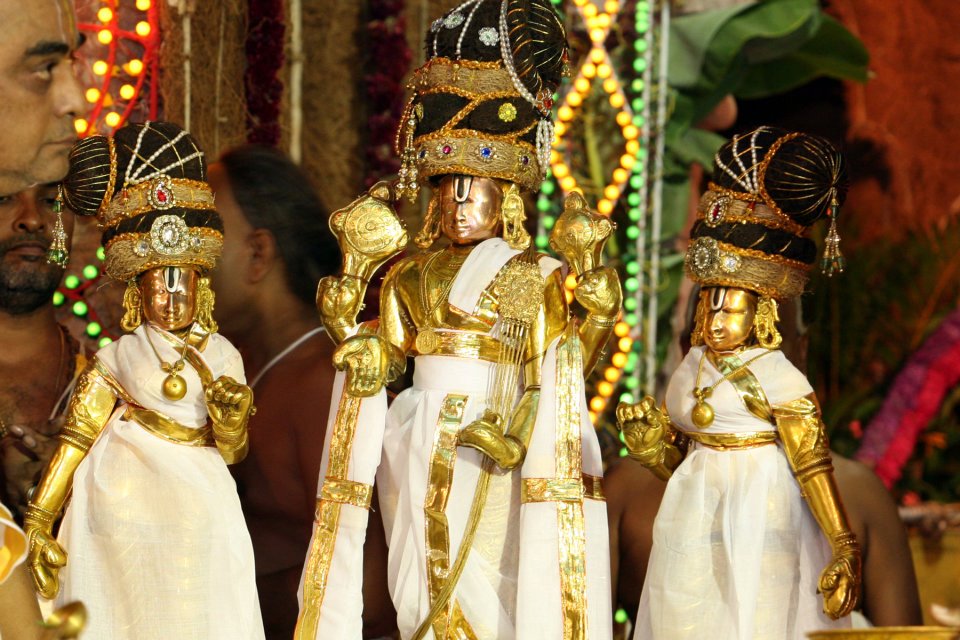A Letter from Anudinam.org reader:
Why We Mustn’t Call God an “Idol”!
Recently, I was reading one of my favourite blogs, when I noticed that the writer made an interesting observation about this website. While he wrote that he enjoyed the website, he also noted that we have the horrendous habit of referring to our arca murtis as “idols”.
Many of us may not realize the negative connotations that the word “idol” brings with it. We may have always used it as the natural English equivalent of “archa murtis”, but it is far from the truth. Here is why:
- Dictionaries will tell you that the word idol is used to denote “any material object worshipped as God”. It is used to signify “blind admiration and devotion”. Notice the use of “blind”-it is used when false or undue importance is given to a material object.
- Idolatry is a general term which refers to blind worship of a physical object, and giving it undue regard as holy. In other words, it is a common term for an unscientific form of worship, much opposite to our Vedic religion.
- Abrahamic religions (like Christianity, for example) forbid idolatry, calling it the basest sin. They cannot understand how a moulded stone or metal can be God.
Queen Victoria was staunchly against idol worship. The reflections of her stringent measures to wipe out “idolatry” were felt in India as well, even as the colonists tried to curb Indian religious practices, although it didn’t have the desired effect.
Here’s why our form of worshipping is NOT what people usually term “IDOL WORSHIP”
- Ours is not an unscientific religion where we worship some random object. Rather, the Vedic guidelines set down specific rules for the same.
- We are entailed to do “PRATISHTAI” in a regulated manner: This is our way of inviting the Lord and offering ourselves lovingly in His service.
- Technically, it is not the material object which we celebrate, but it is our Lord. We love, serve and surrender unto our Supreme Master, not some force of nature or a physical object.
- Not all archa murtis are “man-made”.
- Even if they are man-made, the pratishtai has been performed, differentiating it from what is called “blind worship”.
With what little I do know, I have tried to put together this article, in order to urge fellow Sri Vaishnavas NOT to use the derogatory term “idol” with reference to the archa murtis of Perumal and Thaayar; in this website or elsewhere.
One of the challenges of an English magazine such as Anudinam, in catering to a religion which has its foundations in Tamil and Sanskrit, is not just to convey a message, but to do so accurately. The evolution of language is based on the sensibilities of the speakers. Hence, it is important that we understand the cultural gulf between the traditional medium of our scriptures and the medium of our magazine, and accordingly, accommodate the required changes.
I do not think there is an exact translation for “archa murthi”. But, I don’t think you need one, either.
Sample this:
“Invocations to the Eternal Supreme Being, to Whom I offer my salutations!”
If you are still wondering what that was, I was just translating the Ashtakshara!
Sometimes, we better not translate, than to risk reducing the significance of what we are trying to put across.
Article by : K.K
Credits: http://www.deshika.wordpress.com
——————————————————–
Editors Note: Thanks for your article. We will make sure that, such irrelevant words are not used anymore in anudinam and keep sending us your valuable feedback









Please accept adiyen’s humble obeisances. I would first acknowledge and would like to thank the author of the post for enlightning the importance of usage of “Archa-Murti” / “Vigraha” instead of the petty / non significant english dictionary word “IDOL”. I would like to mention another word for using “ArchaMurti” which Srila Prabhupada of Gaudiya Sampradaya has frequently used and seems to sync with the meaning of the same i.e “Deity”. The word itself signifies and certainly can be used incognito with ArchaMurti. I certainly know that all the meanings cannot be expressed in Mleccha Language i.e the so called English but if written if audacity and clarity , certainly all the literatures will be welcomed and appreciated.
I have been translating Tiruvoimozhi and publishing the same in my blogs. These are intended for our countrymen at India and abroad who have had no time to know something about our dharma due to extremely competitive education and career. The language used is to be the one which this category of readers can understand.In certain cases I follow the translation by A. Srinivasa Raghavan in “Nammalvar” published by Sahitya Akademi. Thanks and respects.
Its important to give a brief translation at least, to what the words mean. Certainly one cannot do justice to the original text. And it is true to any language when translated. But such translations help one have a better understanding even if it is small.
I am sure a little sincere effort can give close-translations possible.